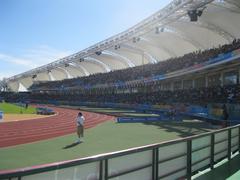
Periférico Norte Zapopan: Visiting Hours, Tickets, and Historical Sites Guide
Date: 04/07/2025
Introduction
Periférico Norte in Zapopan, Mexico, is far more than a major traffic artery—it is a crucial urban connector that bridges the city’s pre-Hispanic roots, colonial heritage, and contemporary urban development. As both a transit hub and a cultural corridor, Periférico Norte and its adjacent light rail station serve not only daily commuters but also visitors eager to explore the region’s rich history and vibrant attractions. Through robust public transportation networks and ongoing infrastructure improvements, the area offers seamless connectivity across Zapopan, Guadalajara, Tonalá, and Tlaquepaque, making it a gateway to the broader metropolitan experience.
Whether your interests lie in exploring historic sites like the Basílica de Nuestra Señora de Zapopan, experiencing cultural venues such as the Centro Cultural Universitario, or simply navigating the city with ease, this comprehensive guide delivers all the practical information and local insights you need. Learn about visiting hours, ticketing, transit options, accessibility features, safety tips, and the best nearby attractions. Utilize travel tools like the Audiala and Moovit apps for up-to-date details, and discover how Periférico Norte exemplifies Zapopan’s commitment to honoring its heritage while fostering sustainable urban growth (lahistoria.info, en.wikipedia.org, itdp.org, oem.com.mx).
Table of Contents
- Introduction
- Historical Context and Urban Development
- Key Transit Infrastructure and Modernization
- Socioeconomic Impact and Cultural Importance
- Visitor Information: Hours, Tickets, and Facilities
- Transportation and Accessibility
- Safety and Travel Tips
- Nearby Attractions and Day Trips
- Frequently Asked Questions (FAQ)
- Visuals and Interactive Resources
- Summary and Recommendations
- References
Historical Context and Urban Development
Pre-Hispanic and Colonial Origins
Zapopan’s history stretches back to its settlement by the Coca people, whose agricultural and ceremonial traditions shaped the area. The name “Zapopan” derives from the Nahuatl “Tzapopan,” signifying “among the sapote trees,” and hints at the region’s natural wealth (lahistoria.info). Officially founded in 1541, Zapopan flourished as a religious and commercial center, with the Basílica de Nuestra Señora de Zapopan standing as a testament to the convergence of indigenous and Spanish cultures.
Urban Growth and the Creation of Periférico Norte
Responding to Guadalajara’s rapid expansion in the 20th century, planners established the Anillo Periférico Norte—now known as Periférico Norte—to decongest the city center and connect outlying neighborhoods. This ring road forms Zapopan’s northern boundary, linking key areas and municipalities while anchoring significant transit developments (mapa-metro.com). The intersection with Calzada Federalismo is home to the Periférico Norte light rail station, underlining its strategic importance (en.wikipedia.org).
Evolution of the Guadalajara Light Rail System
Guadalajara’s transit history began with mule-drawn trams in the 19th century (trains-and-railroads.com). Modernization efforts in the 1970s led to the development of the SITEUR light rail, whose Line 1 opened in 1989 and established Periférico Norte as a pivotal terminal, connecting the core city to northern suburbs.
Modernization and Expansion of Periférico Norte Station
Between 2014 and 2017, Periférico Norte station underwent major renovations, transforming it into an underground facility to enhance multimodal connectivity and traffic flow (en.wikipedia.org). Today, the station seamlessly integrates light rail, BRT, and bus networks, and its distinctive ring-shaped logo symbolizes its northern gateway status.
Socioeconomic Impact and Urban Renewal
From 2024 to 2027, more than 200 million pesos are being invested in infrastructure and social programs around Periférico Norte. New underpasses and expanded facilities aim to reduce congestion, foster economic growth in neighborhoods like Las Cañadas and Valle Real, and improve safety (oem.com.mx). The area’s proximity to cultural venues, such as Auditorio Telmex and Conjunto Santander de Artes Escénicas, enhances its urban vitality.
Cultural and Community Significance
Periférico Norte serves as a bridge between the city’s heritage and its future. It connects diverse communities and provides access to attractions like the Basílica de Zapopan, Museo Huichol Wixárika, and Bosque Los Colomos, while hosting festivals and events that reinforce Zapopan’s dynamic identity (lahistoria.info).
Key Transit Infrastructure and Modernization
- Periférico Norte Station: Now underground since 2017, it operates as a major transit exchange for light rail, BRT (Mi Macro Periférico), and bus services (en.wikipedia.org), (itdp.org).
- SITEUR Line 1: Spans 16.5 km with 19 stations, connecting Periférico Norte in the north to Periférico Sur in the south (mapa-metro.com).
- Mi Macro Periférico BRT: This BRT system runs parallel to Periférico Norte, linking major routes and serving as a model for sustainable urban transport.
Visitor Information: Hours, Tickets, and Facilities
Periférico Norte Station (SITEUR)
- Operating Hours: Daily, 5:00 AM – midnight.
- Tickets: Single rides cost approximately 9 pesos; discounts available for students and seniors. Purchase via vending machines or the SITEUR app.
- Accessibility: Elevators, ramps, tactile paving, and accessible restrooms.
- Facilities: Security staff, information desks, and accessible design for all travelers.
Key Nearby Attractions
Centro Cultural Universitario
- Hours: Tuesday to Sunday, 10:00 AM – 6:00 PM; closed Mondays.
- Admission: Generally free. Special events may charge a fee (50–100 MXN). Buy tickets on-site or online.
Bosque Los Colomos
- Hours: Daily, 6:00 AM – 8:00 PM.
- Admission: Free.
Andares Shopping Mall & Puerta de Hierro
- Hours: Daily, 10:00 AM – 9:00 PM.
- Admission: No entry fee.
For special events or tours, check official websites for hours and ticketing requirements.
Transportation and Accessibility
Getting There
- By Air: Guadalajara International Airport (GDL) is 25 miles (40 km) southeast. Taxis (350–500 MXN), ride-hailing, and public buses offer direct connections.
- By Bus: Routes such as 623, 624, 627, A06, A10, and T01 serve Periférico Norte and nearby attractions. Fares: 9.50–12 MXN.
- By Light Rail (SITEUR): Line 1 connects Periférico Norte; Line 3 (TL-3) serves Plaza Patria, close to key destinations.
- By Taxi/Ride-Hailing: Uber, DiDi, and local taxis are widely available; short rides within Zapopan cost 50–150 MXN.
- By Car: Car rentals start at 500 MXN/day. Parking is available but limited during peak hours.
Navigating the Corridor
- Transit Hubs: Centro Cultural Universitario and Plaza Patria are major stops with easy transfers between bus and light rail.
- Apps: Use Moovit or Audiala for real-time schedules, route planning, and fare information (Moovit Zapopan).
Accessibility
Buses and light rail are wheelchair accessible. Main stops offer ramps, elevators, and tactile features for visually impaired travelers.
Safety and Travel Tips
- Use pedestrian bridges to cross Periférico Norte; avoid jaywalking.
- Stay alert during peak traffic (7:00–9:30 AM, 5:00–8:00 PM).
- Secure personal belongings in crowded areas.
- Prefer official taxis and ride-hailing, especially at night (Mexico Travel Secrets).
- Carry a rechargeable transit card and small change.
- Use translation apps as English signage is limited outside tourist zones.
Nearby Attractions and Day Trips
- Basílica de Nuestra Señora de Zapopan: Major religious site, 15 minutes from Periférico Norte by bus or taxi.
- Centro Cultural Universitario: Cultural events, concerts, and exhibitions.
- Bosque Los Colomos: Historic urban park with gardens and walking trails.
- Andares Shopping Mall: High-end retail and dining.
- Day Trips: Downtown Guadalajara (30–40 min), Lake Chapala (1 hour), Tequila town (1.5 hours).
Frequently Asked Questions (FAQ)
Q: What are the station’s hours?
A: 5:00 AM to midnight, daily.
Q: How do I buy tickets?
A: At station vending machines or via the SITEUR app.
Q: Is the area accessible for disabled visitors?
A: Yes, with elevators, ramps, and tactile paths.
Q: Which bus routes connect at Periférico Norte?
A: 623, 624, 627, and additional feeder lines.
Q: Are there guided tours or special events?
A: Some cultural sites offer guided tours; check their websites or local tourism portals for schedules.
Visuals and Interactive Resources
- [Insert images: “Centro Cultural Universitario entrance in Zapopan,” “Aerial view of Periférico Norte ring road”]
- [Embed an interactive map showing transit stops and attractions along Periférico Norte]
Summary and Recommendations
Periférico Norte stands as a dynamic interface between history and modernity in Zapopan. The integration of advanced transit systems, substantial urban investment, and proximity to cultural and historical landmarks make it an ideal starting point for both locals and visitors. By leveraging real-time transit apps, avoiding peak congestion, and utilizing accessible infrastructure, you can enjoy a safe, efficient, and enriching experience.
For the most up-to-date transit information, download the Audiala app, and explore further with resources like Moovit and official local tourism channels.
References
- This is a sample text. (lahistoria.info)
- This is a sample text. (en.wikipedia.org)
- This is a sample text. (itdp.org)
- This is a sample text. (oem.com.mx)
- This is a sample text. (trains-and-railroads.com)
- This is a sample text. (mapa-metro.com)
- This is a sample text. (Mexico Travel Secrets)
- This is a sample text. (Moovit Zapopan)



